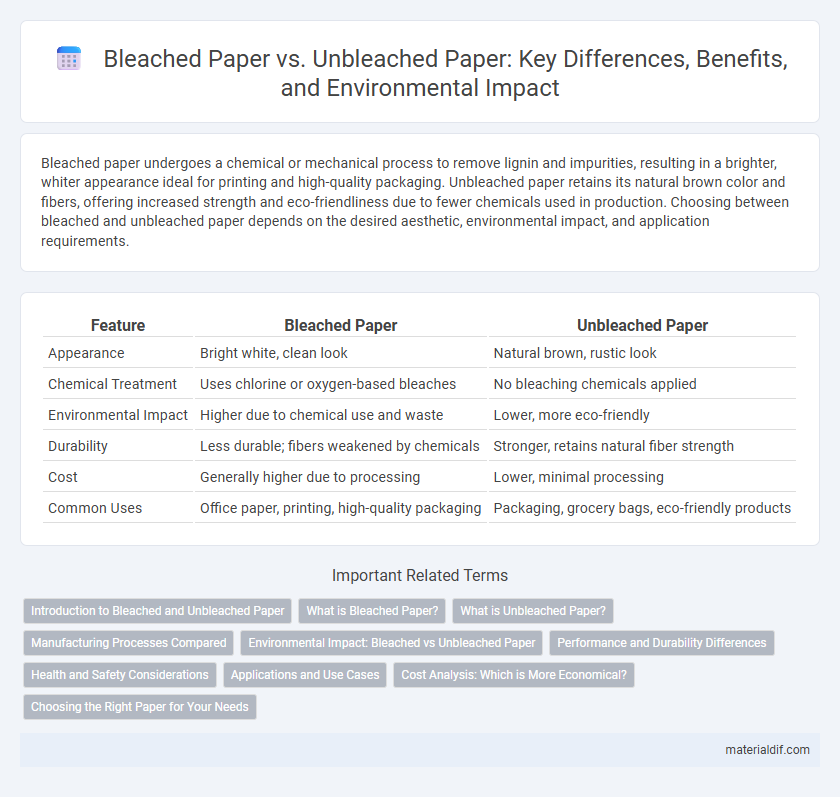Bleached paper undergoes a chemical or mechanical process to remove lignin and impurities, resulting in a brighter, whiter appearance ideal for printing and high-quality packaging. Unbleached paper retains its natural brown color and fibers, offering increased strength and eco-friendliness due to fewer chemicals used in production. Choosing between bleached and unbleached paper depends on the desired aesthetic, environmental impact, and application requirements.
Table of Comparison
| Feature | Bleached Paper | Unbleached Paper |
|---|---|---|
| Appearance | Bright white, clean look | Natural brown, rustic look |
| Chemical Treatment | Uses chlorine or oxygen-based bleaches | No bleaching chemicals applied |
| Environmental Impact | Higher due to chemical use and waste | Lower, more eco-friendly |
| Durability | Less durable; fibers weakened by chemicals | Stronger, retains natural fiber strength |
| Cost | Generally higher due to processing | Lower, minimal processing |
| Common Uses | Office paper, printing, high-quality packaging | Packaging, grocery bags, eco-friendly products |
Introduction to Bleached and Unbleached Paper
Bleached paper undergoes chemical treatments to remove lignin and achieve a white, bright appearance, making it ideal for printing and high-quality packaging. Unbleached paper retains its natural brown color and lignin content, offering increased strength and environmental benefits due to reduced chemical use. Both types serve distinct purposes in industries like packaging, printing, and publishing based on their appearance, durability, and environmental impact.
What is Bleached Paper?
Bleached paper undergoes a chemical treatment process that removes lignin and natural color from wood pulp, resulting in a brighter, whiter finished product. This process often uses chlorine-based or oxygen-based bleaching agents to achieve high brightness and improved purity. Bleached paper is preferred for applications requiring a clean, crisp appearance, such as printing and packaging.
What is Unbleached Paper?
Unbleached paper is made from natural fibers that have not undergone the chemical bleaching process, preserving their original brown or tan color. It retains more lignin and other natural components, resulting in increased durability and environmental friendliness compared to bleached paper. Commonly used for packaging, notebooks, and eco-friendly products, unbleached paper offers a sustainable alternative with a lower chemical footprint.
Manufacturing Processes Compared
Bleached paper undergoes chemical treatments using chlorine or chlorine dioxide to remove lignin and brighten the fibers, resulting in a whiter, more aesthetically pleasing product. Unbleached paper skips this process, retaining its natural brown color and higher lignin content, which makes the manufacturing less resource-intensive and more environmentally friendly. The bleaching process increases energy consumption and chemical waste, whereas unbleached paper production emphasizes sustainability with reduced chemical use and simpler manufacturing steps.
Environmental Impact: Bleached vs Unbleached Paper
Bleached paper undergoes chemical treatments involving chlorine compounds that release harmful dioxins and increase water pollution, significantly impacting aquatic ecosystems. Unbleached paper, produced without these chemicals, reduces toxic waste and has a lower carbon footprint during manufacturing. Choosing unbleached paper supports sustainable forestry practices and decreases environmental degradation associated with paper production.
Performance and Durability Differences
Bleached paper offers a smoother surface and higher brightness, making it ideal for printing and packaging requiring sharp graphics, while unbleached paper provides greater durability and resistance to tearing due to its coarser fibers. The bleaching process weakens cellulose fibers, reducing tensile strength compared to unbleached variants that retain natural lignin content for enhanced durability. In applications demanding longevity and environmental sustainability, unbleached paper outperforms bleached paper by maintaining higher mechanical integrity under stress.
Health and Safety Considerations
Bleached paper undergoes chemical treatments involving chlorine-based agents that can release trace amounts of harmful substances like dioxins, potentially impacting indoor air quality and posing health risks with prolonged exposure. Unbleached paper remains free from such chemical residues, reducing exposure to toxic compounds and making it a safer choice for sensitive environments, including food packaging and medical applications. Choosing unbleached paper supports healthier indoor environments by minimizing the risk of allergic reactions and chemical sensitivities linked to bleaching agents.
Applications and Use Cases
Bleached paper, known for its bright white appearance and smooth surface, is commonly used in high-quality printing, packaging, and office paper products where visual appeal and print clarity are essential. Unbleached paper, retaining its natural brown color and higher strength, is preferred for eco-friendly packaging, grocery bags, and industrial uses where durability and environmental sustainability are prioritized. Applications in food packaging, book covers, and shipping materials often depend on the choice between bleached and unbleached paper based on factors like aesthetic requirements and environmental impact.
Cost Analysis: Which is More Economical?
Bleached paper generally incurs higher production costs due to additional chemical processing and energy consumption, making it more expensive than unbleached paper. Unbleached paper benefits from lower material and manufacturing expenses, offering a cost-effective solution especially for bulk or industrial uses. When evaluating cost efficiency, unbleached paper provides greater economic advantages without compromising functionality in many applications.
Choosing the Right Paper for Your Needs
Bleached paper offers a bright, white appearance ideal for high-visibility printing and professional documents, while unbleached paper retains a natural, earthy tone preferred for environmentally friendly packaging and artisanal products. Consider the specific use case: bleached paper is often better for marketing materials requiring sharp contrasts, whereas unbleached paper supports sustainability goals due to its lower chemical processing. Selecting between bleached and unbleached paper depends on balancing aesthetic requirements with environmental impact and product purpose.
Bleached Paper vs Unbleached Paper Infographic

 materialdif.com
materialdif.com